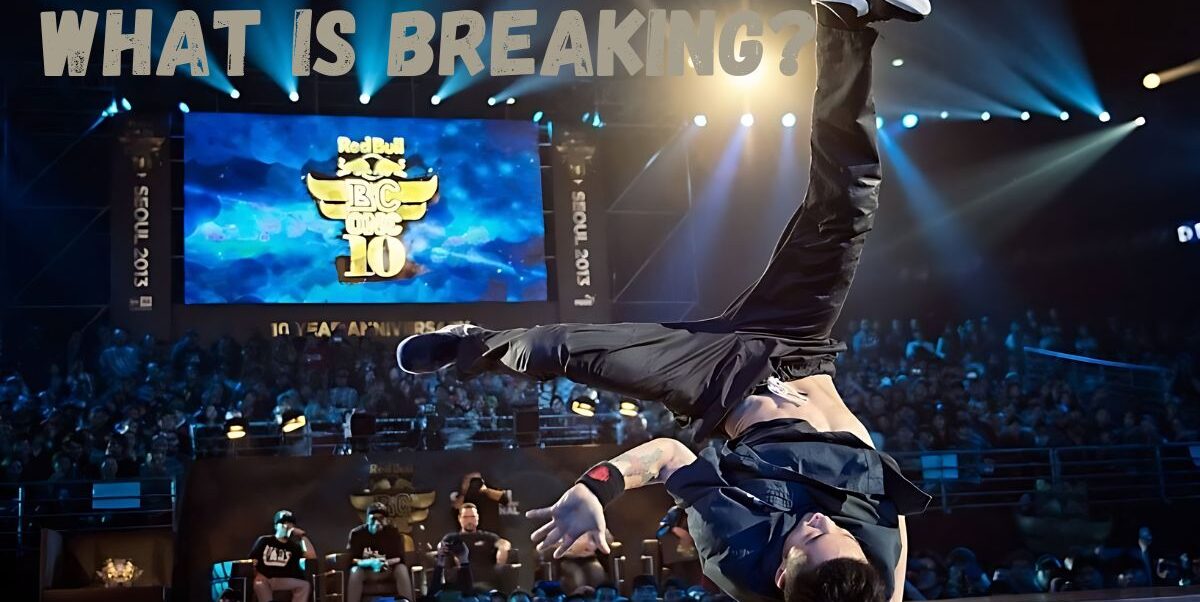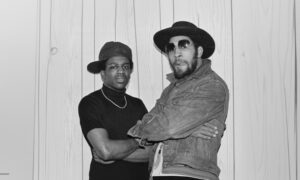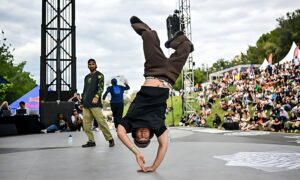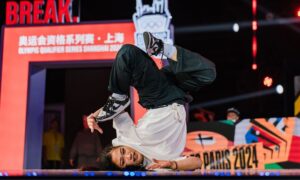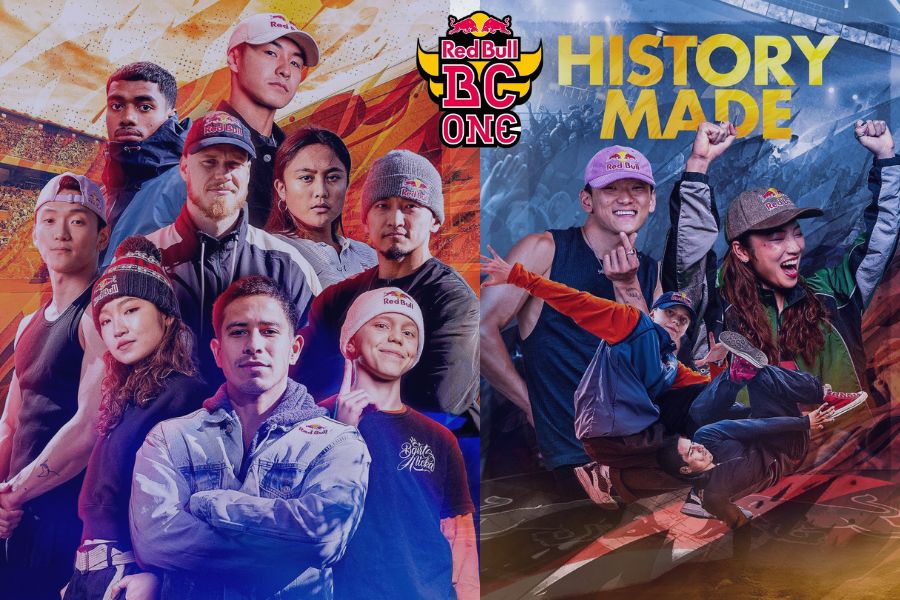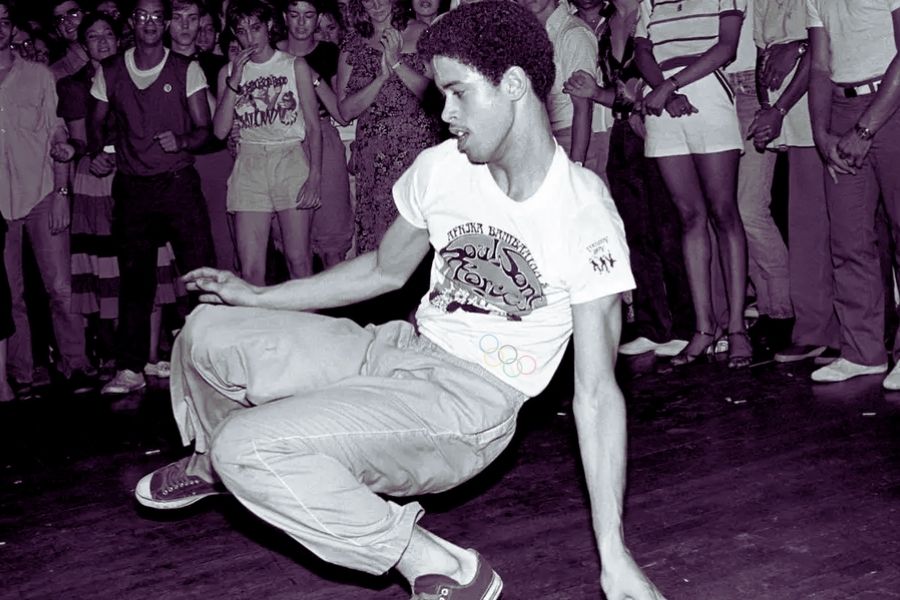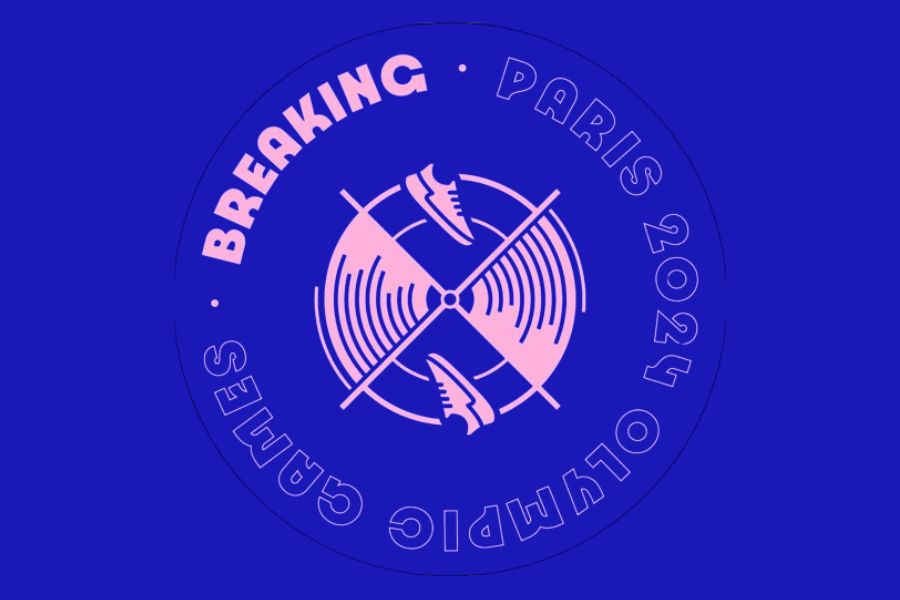What is Breaking & Break Dance Meaning?
Breaking is an athletic and acrobatic style of dance that involves dynamic moves such as spinning on the head and hands. It includes moves for every level, from standing to floor work and even airborne maneuvers. Breakers will do shuffles, kicks, stances, & gestures while standing and often perform with their hands and legs touching the ground to create different patterns. They dance to hip-hop, funk, and breakbeat music, often engaging in battles or competitions.
How did Breakdancing start and Who Originated it?
Breaking started in the 1970s in the Bronx, New York City, by African-American and Latino youths. It was during the early days of hip-hop when a DJ named Kool Herc used to throw parties where he noticed that young people would dance with a lot of energy when the music reached a part called the ‘break,’ where only the drums played. To give the dancers more time, Kool Herc played two copies of the same record on two turntables, switching between them to extend the break. This inspired the dance style known as ‘breaking,’ because dancers would perform to the break of the music.
What is a Bboy, Bgirl & Breaker?
The ‘B’ in Bboy and Bgirl stands for Break (Break-Boy & Break-Girl) and the dance that these Bboys & Bgirls do is known as Bboying and Bgirling respectively. These terminologies originated because the dancers or we might as well refer to them as “Breakers” would perform on the instrumental break part of the track.
Basic Elements of Breaking
Breaking has many elements, but only has four fundamentals. These primary components are Toprock, Downrock, Power Moves, and Freezes.
1. Toprock
Toprock is performed from a standing position with the use of feet & hand movements. It involves rocking, bounces, grooves, style, rhythm, and personality. Traditionally it is used as the introduction to a breakdancer’s round but recent breakers have made it more diverse & connected with the rest of the dance movements. Indian step, crossover step, salsa step are a few examples of top rocks.
2. Downrock
Downrock is footwork performed on the floor, with hands and feet touching the ground. Breakers use footwork to create various patterns and movements such as circular patterns with Six Steps, Coffee Grinder, Three Steps, and more. CCs and hooks are examples of different patterns. Footwork is considered a fundamental difference that sets breaking apart from other dance forms.
3. Power Moves
You must have seen someone spinning on their head or hopping on their hands. These are power moves. Power moves make breaking more athletic and sporty, as they are acrobatic and dynamic moves that take months to learn. They bring the most ‘wow’ and visually impressive aspect to a breaking performance.
4. Freezes
Freezes act as the commas and full stops of breaking. These are the stances, poses, and holding positions that display artistic balance and control of movement. Commonly, freezes are executed during instrumental breaks, pauses in the music, or beat drops. Baby Freeze, Chair Freeze, Headstand, and Elbow Freeze are among the most common freezes.
Breaking or Breakdancing: What’s the Right Term?
Breakdancing is not the original term; it was created by the media from outside of the culture. The breaking community looks down on the term “breakdancing” as a misrepresentation of the original cultural context. Due to the media’s influence in the ’80s, “breakdance” became a commercial term, though the original term is “breaking,” which comes from the word “breakbeat.”
Bboy K-mel explains: “A breakdancer has no style, no originality, but they probably have some dynamic moves that people can’t do. A b-boy or b-girl doesn’t really care about dynamic moves; they care about dynamic style.”
According to Bboy Focus: “If you call yourself a b-boy or b-girl, then it’s something that’s part of your identity. It’s a lifestyle for you, whereas a breakdancer might break once a week or once every two weeks—something they do for a short period of time. If you call yourself a b-boy or b-girl, that’s what you are; it’s not just something you do.”
Read complete backstory of Breaking or Breakdancing.
Breaking is a Sport or a Dance?
Breaking is a dance form that is part of hip-hop culture. It requires artistic expressions and performance art. However, this dance form also involves athleticism, acrobatic moves, and competitions, which makes it a dance sport. It is the first dance sport to be included in the Paris Olympics in 2024. Breakers train full-time, and there are official rules and judging systems to ensure fair competition, just like any other sport. Its inclusion in the Youth Olympics (2018) and now Breaking at the 2024 Paris Olympics has given more exposure to the sports aspect of breaking.
Culture of Breakdancing/Breaking
Breakers will train rigurously every day to master their craft. They will normally be seen performing below cultural activities:
1. Crews: Crew culture is fundamental in breaking. Crews are tight-knit groups of breakers that serve the purpose of identity and representation within the community. They train together regularly, sharing knowledge, skills, and techniques. Crews compete against other top crews locally, nationally, and internationally to earn respect and titles. Even in solo battles, a breaker’s name is announced alongside their crew’s name, as they always represent their crew.
2. Battles: Battle is central to breaking culture. It’s an exchange of rounds between two breakers or crews. Battles are not just about showcasing skill but also about earning respect and status within the community. They can take place on the streets, at well-organized local events, and at global competitions such as Red Bull BC One, Battle Of the Year, the Olympics Games, and more.
3. Call-Outs: On the matter of disrespect or personal beef or on a friendly gesture, a breaker will call out another breaker to get down with them on floor for unexpected numbers of rounds. This is where they exchange their breaking rounds & try to put the point that their skill level is higher. Call-outs can happen during competitions, cyphers or randomly on streets.
4. Cyphers: Cyphers are circular gatherings where breakers take turns dancing in the middle to showcase their skills and engage in informal communication. The type of cypher can vary; breakers might participate in power moves cypher, footwork cyphers, or full rounds to demonstrate their complete breaking skills. It’s like a showcase where B-boys and B-girls display their breaking knowledge through their skills, their moves, and their overall “vocabulary” of breakdancing.
The idea of the cypher isn’t just for breaking, In rapping too, rappers use cyphers to exchange verses, battling and practising their skills.
5. Community:Breakers proudly wear this art form as a badge of honor, using it to connect, exchange, and collaborate with fellow practitioners. Any newcomer can easily integrate with local community by simply showing up. The worldwide community also embraces Bboys and Bgirls from every corner of the globe, welcoming them to practice or compete anywhere.
6. Knowledge: Breaking into hip-hop culture involves passing on positive learning and tips to the upcoming generation. Knowledge is highly valued and is often considered the fifth element of hip-hop culture. This knowledge encompasses not only the ‘how’ of the dance but also the study of the background, history, and meaning of every move.
Impact of Breaking in Hip Hop Culture

Breaking provided a platform for DJs to experiment with isolating and extending the “break” sections of songs, creating the rhythmic foundation for breakdancing to expand more. This back-and-forth influence helped shape the development of hip-hop music itself. Breakdancing crews often wore distinct clothing styles, like baggy pants, tracksuits, and sneakers, which influenced overall hip-hop fashion. Bgirls & Bboys are often found dancing to rap music or beatboxing, creating reels and videos against graffiti walls. Breaking has remained the essence of HipHop, consistently staying true to the culture’s other elements.
When did Breakdancing Become Popular?
Breakdancing became popular in the 1980s as a hip-hop dance element and got mainstream attention through movies like “Flashdance” (1983) and “Breakin'” (1984). It gained immense popularity when international competitions started to take place like the Red Bull BC One and the Battle of the Year. Following that, the International Olympic Committee announced that breaking would be included in the 2024 Paris Olympics, making it a globally recognized dance sport.
Conclusion
Breaking, originating in the Bronx in the 1970s, has grown into a global symbol of hip-hop culture. Its dynamic moves reflects both athleticism and artistic expression. Despite commercial misrepresentation in 80s, breakers uphold its authenticity and heritage. With inclusion in events like the 2024 Paris Olympics, breaking continues to evolve, embodying the enduring spirit of hip-hop worldwide.
Breaking HISTORY & the RISE of the ART FORM | ABC of Breaking:
Join our exclusive community for the latest updates straight to your inbox! Don't miss out –subscribe now!
